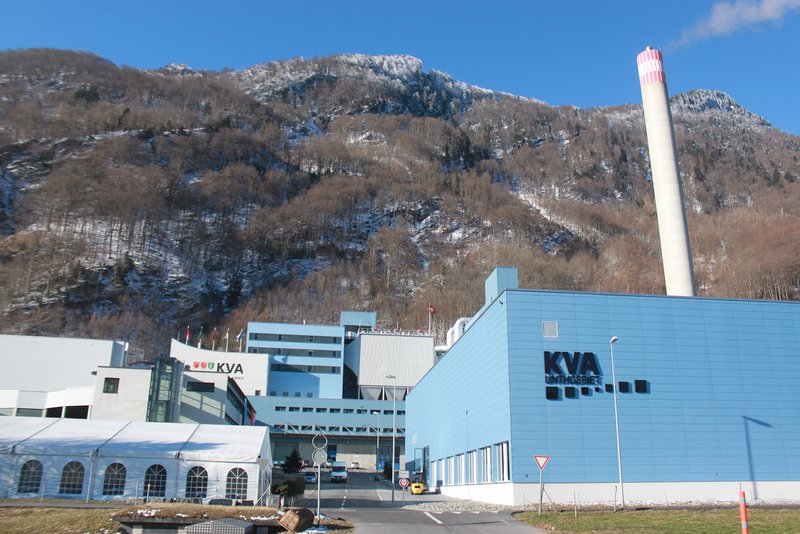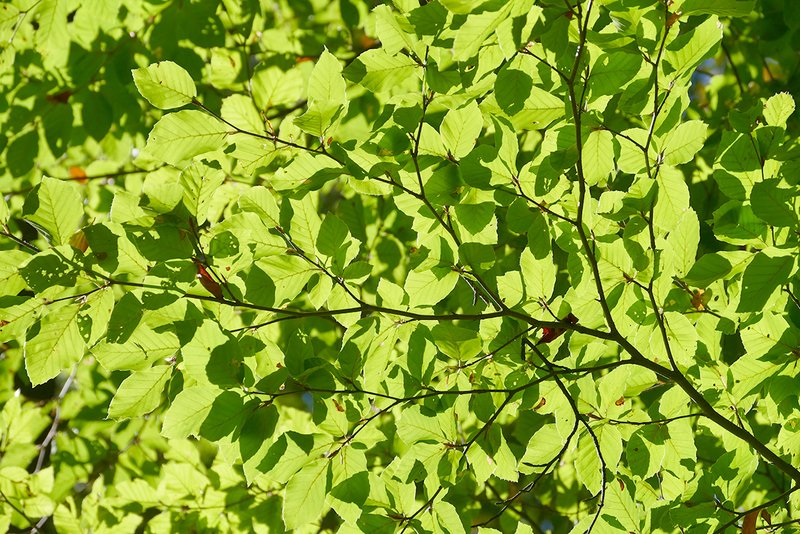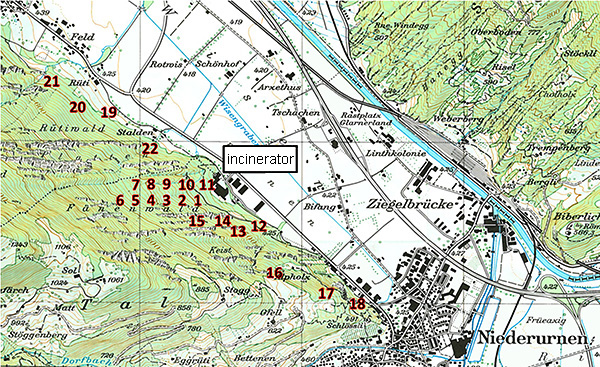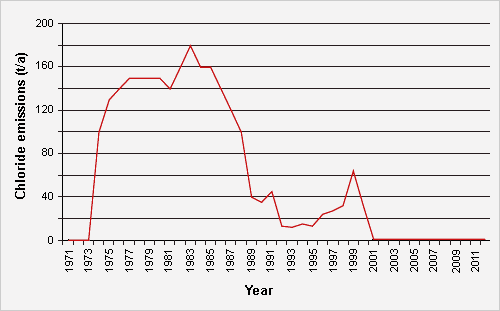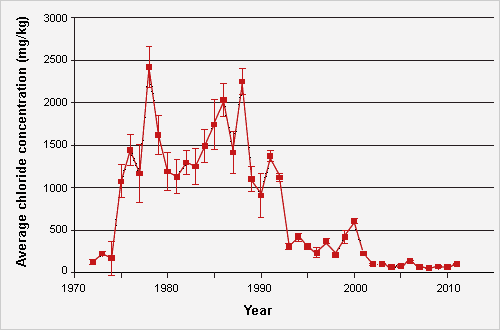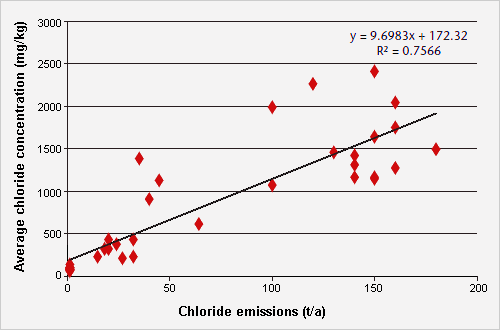For 40 years, from 1971 until 2011, researchers investigated the concentration of chloride, heavy metals and other elements in the foliage of a beech forest in the surrounding area of a waste incinerator. This very clearly indicated the technical improvements made to the incinerator and the accompanying reduction in emissions of hazardous substances, with the concentration of chloride and zinc in the leaves proving an effective bioindicator of environmental pollution.
The Niederurnen waste incinerator is situated in the Linth Plain at the foot of a mountain slope stocked with beech trees in the Swiss canton of Glarus (Fig. 1). It was opened in late 1973, and subsequently extended in various phases and fitted with additional waste-gas purification systems. The incinerator processed the waste of around 240,000 residents in 2014, amounting to an annual volume of some 110,000 tonnes of waste.
As a prerequisite for obtaining planning permission at that time, the local commune of Niederurnen demanded that for three years before the commissioning of the incinerator and every year after that, leaf samples be examined from the neighbouring forests for traces of chloride and heavy metals, resulting in what might well be a unique unbroken series of measurements stretching back 40 years and covering various phases of the waste-gas purification process.
In 1971, staff from the Swiss Federal Institute for Forest, Snow and Landscape Research WSL in consultation with the local forester designated a network of 20 sampling sites on the mountainside above the incinerator (Fig. 3). The sites were distributed in a fan shape between the northwest and southeast over a distance between 0.15 and 1.2 km from the chimney und over altitude differences ranging from 30 to 220 metres above the bottom of this chimney. At each of these 20 locations, two approximately 100-year-old beech trees (Fagus sylvatica) were marked out for sampling. In 1984, two extra sites to the northwest were added.
Emission measurements
The incinerator's gaseous chloride emissions (hydrogen chloride) have been measured periodically. From 1990 until 1999, a device carrying out continuous measurements was used additionally. Since 1999, the Swiss Federal Laboratories for Materials Science and Technology (Empa) at Dübendorf has worked out the emissions of chlorine compounds and heavy metals every three years by means of random sampling.
However, when it was commissioned in late 1973, the Niederurnen incinerator was fitted with an electric filter but no other flue-gas purification system. This led to the chlorine compounds in the waste getting into the environment almost without reduction (Fig. 4). In 1985, a new incineration line with an advanced dry process-based flue-gas purification system was brought online. This gradually reduced chloride concentrations in the waste gas to around 10 mg/m3 by 1991.
In subsequent years, though, these values increased again as a result of a greater volume of waste and a rising number of operational disruptions. In 2000, the incinerator was completely renovated, the chimney raised from 68 m to 100 m, and a new system for wet-cleaning the waste gases came into service. This cut emissions considerably, generally bringing them below the detection limit of the measuring procedure
Chloride concentrations in the leaves
From the marked trees, every August, so before the leaves become discoloured, some 200 grams of sun leaves were harvested from the top third of the crown of the two trees at each location (Fig. 5) and mixed up to each form a sample. The researchers dried the unwashed mixed leaf samples and then ground them down to form a leaf powder. Using this, they determined the concentration of chloride ions and of other elements.
From the measurement values for the various sites, the researchers worked out the mean value (Fig. 6). Before the incineration started operations, it amounted 179 mg of chloride per kilogram of leaf dry weight, rising after commissioning to a record high of 2’400 mg/kg in 1977. The average for the first 15 years of operation (1974–1988), when the incinerator was producing high levels of chloride emissions, was 1’500 mg/kg. Although emissions dropped sharply from 1989 onwards, the chloride concentrations in the leaves only fell significantly in 1992 following several years' time lag, with the mean value for 1992–2000 then coming to only 340 mg/kg. Since 2001, values have consistently been achieved that are even below the original levels recorded between 1971 and 1973.
Blown by the wind, chloride ions that were emitted in gaseous form from the incinerator accumulated in the leaves of the beech trees. In this context, there was a good correlation between the average chloride concentrations in the leaves and the changes in emissions (Fig. 7).
Concentrations of metals and nutrient elements in the leaves
In the period from 1974 to 1985, the incinerator also emitted metal dust, containing elements such as zinc, lead and cadmium. Some of this dust was filtered from the air by the leaves, while mobile metals like zinc and cadmium also got into the trees later through the soil.
In the years that followed, as waste-gas purification improved, the concentrations of zinc, cadmium, chromium and nickel in the leaves declined, concomitant with the chlorides, and since 2001 have dropped below the levels measured before the incinerator was put into operation.
Lead, unlike zinc, is hardly absorbed into plants, and so the content of lead in the beech leaves scarcely changed because of the incinerator being in service. As a result of their decreasing use in fuel for cars, the levels of lead have fallen since the early 1970s, and since 2001 have even dropped below the detection limit.
By contract, since 1974, the concentrations of sulphur measured in the leaves of all the trees being analysed have risen continuously. Aluminium and boron have experienced a similar development, hitting higher levels in recent years than previously. Sodium levels reached their peak after the snowy winters of 2009 and 2011 because of the salt used to make the roads safe in such weather.
There have only been very slight variations in the levels of calcium, potassium, magnesium, manganese, iron and copper – all elements that are crucial for plant growth – over the 40 years. However, at many of the sites the concentrations of nitrogen and phosphorus, both of them major nutrients, were higher from 1974 until 2000 than between 2001 and 2011, possibly representing a fertilisation effect of the incinerator.

Fig. 8: The chloride content of the beach leaves proved a good indicator of the hydrogen chloride emissions of the incinerator. Photo: Thomas Reich (WSL)
Summary
Leaves, in particular those on trees, filter gaseous and dust emissions out of the air. This makes the chloride content of beech leaves a good bioindicator of environmental pollution from waste gases (among which hydrogen chloride forms a key component) arising from waste incineration. This is particularly true in the case presented here, given that there are no other chloride emission sources in the area that have had an impact on long-term development. In Niederurnen, measuring the chloride content of the leaves has proven an excellent guide for monitoring emissions.
Translation : TTN Translation Network

